436. Someone sent in a photo hoping to find out what this is. It was among the items to be tossed out from an old municipal building in Pennsylvania.
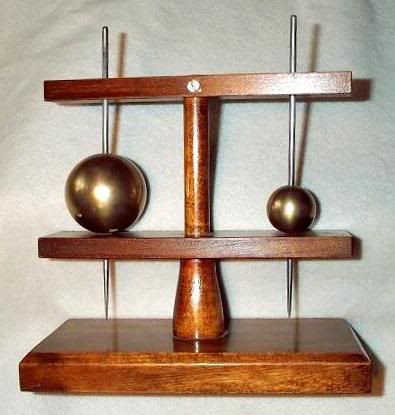
437. This is a close-up of something that everyone would recognize from a different angle.
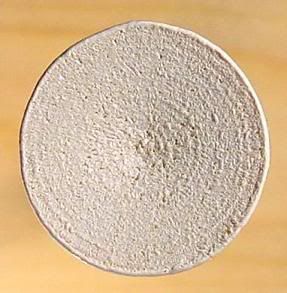
438. 14" long
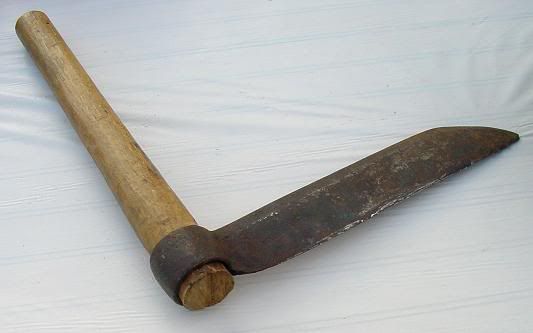
439. 3-3/4" tall
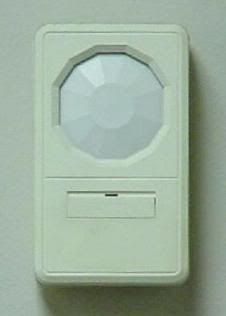
440. A partial shot of something made circa 1948.
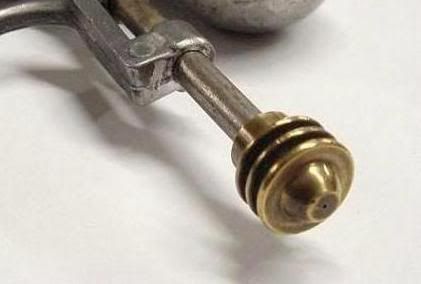
This is the other end of it:

441. 48" tall
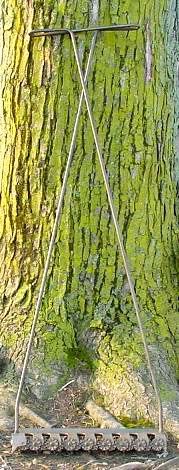
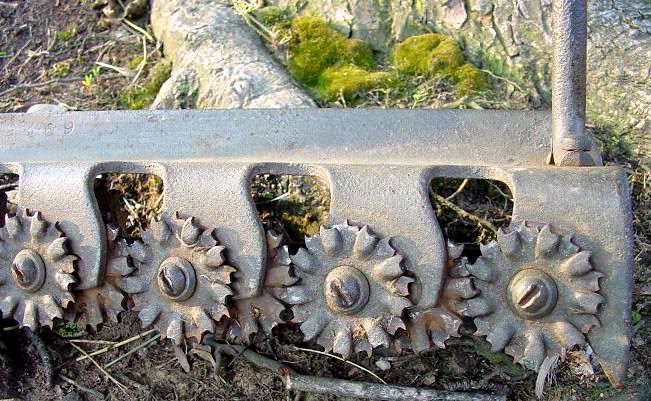
Answers

437. This is a close-up of something that everyone would recognize from a different angle.

438. 14" long

439. 3-3/4" tall

440. A partial shot of something made circa 1948.

This is the other end of it:

441. 48" tall


Answers

18 Comments:
439 Motion sensor
By Anonymous, at 8/25/2005 8:38 AM
Anonymous, at 8/25/2005 8:38 AM
441 A lawn "mower"
By Anonymous, at 8/25/2005 9:58 AM
Anonymous, at 8/25/2005 9:58 AM
439: Motion sensor.
441: Manual Lawn edger.
By Anonymous, at 8/25/2005 5:30 PM
Anonymous, at 8/25/2005 5:30 PM
>437. golf tee
Yes
>439. night light
This one isn't a light
>438 - A Froe
>439 Motion sensor
>441 A lawn "mower"
>439: Motion sensor.
All correct
>441: Manual Lawn edger.
I think it's more of a mower than an edger.
Rob
By Rob H., at 8/26/2005 4:21 PM
Rob H., at 8/26/2005 4:21 PM
436. Could they be part of a grandfather's clock mechanism to vary the gong or something? Might be weights for the scales of justice if they came out of a courthouse ¦;¬)
By R.G.B., at 8/26/2005 4:35 PM
R.G.B., at 8/26/2005 4:35 PM
436. Puncture test tool. Not sure what material it was intended to test. Given that it was from a municipal building, I would guess roofing.
- Edward
By Anonymous, at 8/27/2005 12:20 AM
Anonymous, at 8/27/2005 12:20 AM
>436. Could they be part of a grandfather's clock mechanism to vary the gong or something? Might be weights for the scales of justice if they came out of a courthouse ¦;¬)
I'll add these ideas to my list of possibilities, I looked but couldn't find anything similar on the web.
>436. Puncture test tool.
I like this idea, it would explain why the rods and balls are in the frame, though when I did a search I didn't find any puncture test tools that looked like it.
By Rob H., at 8/27/2005 6:50 AM
Rob H., at 8/27/2005 6:50 AM
436. They could be static electricity dischargers like they used in the old days (like Benjamin Franklin's time). The pointed tip was used to concentrate the electric charge (and resulting spark when the charge was discharged). That might explain why the points are protected, as their condition would be important. If they're from Philadelphia, who knows...
I couldn't find any good images on Google of the same device, but this page has lots of similar apparatus:
http://physics.kenyon.edu/EarlyApparatus/Titlepage/Static_Electricity.html
By Anonymous, at 8/27/2005 10:52 PM
Anonymous, at 8/27/2005 10:52 PM
here is rest of address that was cut off:
Titlepage/Static_Electricity.html
By Anonymous, at 8/27/2005 10:53 PM
Anonymous, at 8/27/2005 10:53 PM
436. To support Sawdust's theory. If the globes were hollow and not solid (as I originally assumed), then they would hold a static electric charge relative to their surface area. Someone could generate a charge, e.g. by rubbing a glass rod with a silk cloth, and touch it to the top rod of one globe and then do it again and touch it to the other one. Then one could hold a grounded conductor, e.g. ones finger, below the sharp tips and demonstrate that the spark from the large globe would jump a larger gap than that of the smaller globe.
- Edward
By Anonymous, at 8/28/2005 5:15 AM
Anonymous, at 8/28/2005 5:15 AM
440 bug sprayer?
By Anonymous, at 8/28/2005 2:55 PM
Anonymous, at 8/28/2005 2:55 PM
440: Air Brush Sprayer ??
By Anonymous, at 8/28/2005 5:28 PM
Anonymous, at 8/28/2005 5:28 PM
>436. If the globes were hollow and not solid...
I emailed the person who sent the photos and asked if they were hollow or solid but haven't heard back yet. Right now I'm liking the puncture test and the static experiment prop ideas, it would be nice to verify one of them somewhere.
>440 bug sprayer
>440: Air Brush Sprayer
Neither of these, this one is not a tool of any type, if it was being sold today it wouldn't be found in a hardware store.
By Rob H., at 8/28/2005 5:44 PM
Rob H., at 8/28/2005 5:44 PM
>440. Ray gun, Buck Rogers perhaps
Correct, though it's not a Buck Rogers type, check the answer page for a full photo.
Rob
By Rob H., at 8/29/2005 3:21 PM
Rob H., at 8/29/2005 3:21 PM
>436. They could be static electricity dischargers...
I'll put this idea on my list, I couldn't find any like it, but thanks for the interesting link.
>436. To support Sawdust's theory. If the globes were hollow and not solid...
I just got an email from the owner of this one he says that the balls are solid, also it's 9" tall to the top of the rods.
By Rob H., at 8/29/2005 3:27 PM
Rob H., at 8/29/2005 3:27 PM
436: could it be somthing mundane like a note holder, i.e. place you scrap paper under the pointy things and lower them onto the paper to hold them in place, no one had ac back then so fans were running all the time
By Anonymous, at 9/01/2005 1:59 PM
Anonymous, at 9/01/2005 1:59 PM
436 - I estimate the smaller ball to be about 1 inch in diameter, and the larger about 2 inches. Assuming they are brass, the first ball should weight about 1.25lbs, while the second one would be about 10lbs.
This suggests some test device, where a 2 inch drop is used. The fact that the points seem to end about an inch above the surface probably means it is not a paper holder.
The larger sphere would generate about 8 times the force as the smaller.
It looks like the device was refinished, it would be interesting to know if there were any wear patterns on the device when recovered. For example, if there were scratches on the surface of the bottom plate, we would know that was the working surface. On the other hand, if the device arrived in such a pristine condition, it must have had a function which wasn't needed very often.
My suggestion, completely off the cuff, is that it was ore sample tester. The assayers office may have wanted to determine the hardness and fractability of a mineral sample(or coal) to determine the quality of a mine.
Good luck,
-Flex
By Anonymous, at 10/05/2005 3:12 PM
Anonymous, at 10/05/2005 3:12 PM
436 could also potentially be an objet d'art, especially if it originates from the mid twentieth century. (Much earlier, and it's too abstract; much later, and it's too attractive, with the nicely stained wood and the brass.) Government buildings in the US often end up with one or two of these sorts of things in them, for no very good reason, and in the absense of an explanatory plaque, nobody three or four decades later knows what it is or how it got there. The small-town public library where I work has two or three objects, between 1 and 3 feet tall, vaguely humanoid in shape, made from 20-30 pieces each of scrap metal (all pretty heavy, mostly iron and steel, no aluminum), welded together, painted in haphazard but elaborate combinations of very bright colors. Seriously.
By Jonadab, at 1/19/2007 11:07 PM
Jonadab, at 1/19/2007 11:07 PM
Post a Comment
<< Home